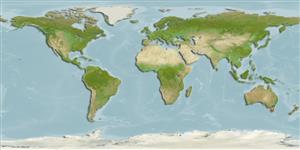Environment: milieu / climate zone / depth range / distribution range
Ecology
Marine; freshwater; brackish; demersal; amphidromous (Ref. 51243). Temperate; 6°C - 20°C (Ref. 2060); 37°S - 44°S
Oceania: widely separated populations in southeastern and southwestern Australia.
Size / Weight / Age
Maturity: Lm ? range ? - ? cm
Max length : 20.0 cm SL male/unsexed; (Ref. 44894); common length : 10.0 cm SL male/unsexed; (Ref. )
Facultative air-breathing in the genus (Ref. 126274); Occurs in still or slow-flowing waters at low elevations close to the sea; most abundant along shore margins in rocky areas. Found around plants, rocks or logs on the margins of still or flowing rivers, streams and lakes (Ref. 44894). The species has a marine juvenile stage, indicative of a diadromous life cycle. Spawning takes place from autumn to winter, among aquatic vegetation. Newly hatched larvae drift downcurrent and out to sea where they spend their first few months, eventually returning to fresh water during spring among annual whitebait migrations. In lacustrine and other landlocked populations, adults move upstream into feeder streams to spawn. The larvae are then swept downstream into lakes (Ref. 44894). Feeds mainly on aquatic and terrestrial insects.
Paxton, J.R., D.F. Hoese, G.R. Allen and J.E. Hanley, 1989. Pisces. Petromyzontidae to Carangidae. Zoological Catalogue of Australia, Vol. 7. Australian Government Publishing Service, Canberra, 665 p. (Ref. 7300)
IUCN Red List Status (Ref. 130435: Version 2024-2)
Threat to humans
Harmless
Human uses
Fisheries: of no interest
Tools
Fatal error: Uncaught mysqli_sql_exception: Too many connections in /var/www/html/includes/speciessummary.lib.php:2004
Stack trace:
#0 /var/www/html/includes/speciessummary.lib.php(2004): mysqli->__construct()
#1 /var/www/html/summary/SpeciesSummary.php(1812): checkRecordDisplayFBQuizV2()
#2 {main}
thrown in /var/www/html/includes/speciessummary.lib.php on line 2004
